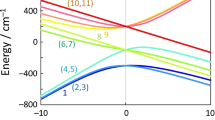Abstract
The energy of stabilization of the crystal field (ESCF) for the MX6 group may be calculated from thermodynamic and from optical data. Values of ESCF obtained from thermodynamic data are always greater than the corresponding values calculated from optical data. The reason for these deviations lies in the inaccuracy of the existing equation for evaluating ESCF from thermodynamic data. The two means arrived at for evaluating ESCF are in agreement with each other if a correction is introduced into the equation for the nonlinear character of the change in the ionic radii of the transition elements by using the “correlation radii” suggested in this paper. Correlation radii have been found for the bivalent ions of manganese, iron, cobalt, nickel, and copper. An equation has been proposed for evaluating the coulomb integrals and the effective charges on the metal atoms in MX6 groups, based upon spectroscopic data (using the parameters Dq). The coulomb integrals and the effective charges on the metal atoms have been calculated in the complexes M(H2O) 2+6 (where M=Fe, Co, Ni), M (NH3) 2+6 (where M=Co, Ni), and NiF 46 . On the basis of these data the “effective bondings” characterizing the difference in the thermodynamic stability of the complexes considered have been calculated.
Similar content being viewed by others
References
K. B. Yatsimirskii, ZhNKh, 3, 2244, 1958.
P. George and D. S. McClure, Progress in Inorg. Chem., vol. 1, 1959. Edit. F. A. Cotton, p. 381.
C. C. A. Schuit, Rec. trav. Chim. Pay. Bas., 81, 21, 481, 1962.
C. K. Jorgensen, Experimentia Suppl. IX Essasy in Coord. Chem., 1964.
K. B. Yatsimirskii, ZhNKh, 6, 518, 1961.
E. S. Lingafeller and H. Montgomery, Proceed. 8 JCCC, Wien, p. 129, 1964.
M. Wolfsberg and L. Helmholz, J. Chem. Phys., 29, 736, 1952.
F. A. Collton and T. E. Haas, Inorg. Chem., 3, 1004, 1964.
C. K. Jorgensen, R. Pappalardo, and H. H. Schmidtke, J. Chem. Phys., 39, 1422, 1963.
R. S. Mulliken, A. Rieke, D. Orloff, and H. Orloff, J. Chem. Phys., 17, 1248, 1949.
V. I. Vedeneev, A. V. Gurvich, V. N. Kondrat'ev, V. A. Medvedev, and E. L. Frankevich, The Breaking Energy of Chemical Bonds. Ionization Potentials and Electron Affinity [in Russian], Handbook, Izd-vo AN SSSR, Moscow, 1962.
R. E. Watson and A. J. Freeman, Phys. Rev., 136 6A A1526, 1964.
C. K. Jorgensen, Absorption Spectra and Chemical Bonding in Complexes, Pergamon Press, 1962.
Author information
Authors and Affiliations
Additional information
Communication to the Symposium on Quantum Chemistry, Palanga, June 1965.
Rights and permissions
About this article
Cite this article
Yatsimirskii, K.B. The connection between the optical and thermodynamic characteristics of transition metal compounds. Theor Exp Chem 2, 1–7 (1967). https://doi.org/10.1007/BF00524249
Issue Date:
DOI: https://doi.org/10.1007/BF00524249




